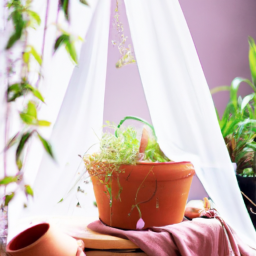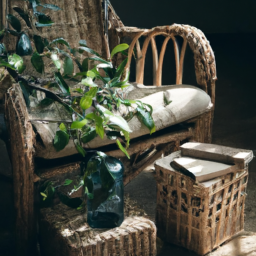
Have you ever felt a sense of calm and tranquility when surrounded by nature? The soothing sound of a gentle breeze, the vibrant colors of blooming flowers, and the fresh scent of the earth can instantly uplift our spirits. It’s no wonder that incorporating elements of nature into our living and working spaces has become a growing trend in interior design. Biophilic design: blending nature and interiors is a concept that seeks to bring the outdoors in, creating spaces that not only look beautiful but also promote our well-being. In this blog post, we will explore the principles and benefits of biophilic design and discover how it can transform our living environments into natural sanctuaries.
Benefits of Biophilic Design in Interior Spaces
Introduction
Biophilic design is an innovative approach to interior spaces that seeks to blend nature and human-made environments. By incorporating elements of nature into our living and working spaces, we can create a more harmonious and productive environment. In this article, we will explore the numerous benefits of biophilic design and how it can positively impact our well-being.
Improved Air Quality
One of the key benefits of biophilic design is its ability to improve indoor air quality. By introducing plants and natural materials into interior spaces, we can enhance air circulation and filtration. Plants act as natural air purifiers by absorbing carbon dioxide and releasing oxygen. They also help to remove harmful toxins from the air, such as formaldehyde and benzene, which are commonly found in synthetic materials. By improving air quality, biophilic design can reduce the risk of respiratory problems and enhance overall health and well-being.
Moreover, the presence of plants in indoor spaces can increase humidity levels, which is particularly beneficial in dry environments. Adequate humidity levels can alleviate respiratory issues, prevent dry skin, and reduce the spread of airborne viruses. Biophilic design offers a natural solution to combat the negative effects of air conditioning and artificial heating systems, creating a healthier and more comfortable indoor environment.
Stress Reduction and Mental Well-being
Incorporating elements of nature into interior spaces has been proven to reduce stress levels and promote mental well-being. Research has shown that exposure to nature, even in the form of indoor plants or natural light, can have a calming effect on the mind and body. The presence of greenery and natural materials in our surroundings can evoke feelings of tranquility and relaxation, helping to alleviate stress and anxiety.
Biophilic design also enhances cognitive function and creativity. Studies have demonstrated that access to natural elements in the workplace can improve concentration, productivity, and problem-solving abilities. The connection to nature stimulates our senses and encourages a sense of curiosity and exploration, leading to increased engagement and innovation. By incorporating biophilic design principles into interior spaces, we can create environments that support mental well-being and foster creativity.
Increased Productivity and Engagement
Another significant benefit of biophilic design is its positive impact on productivity and engagement. By bringing elements of nature into our indoor spaces, we can create environments that are visually appealing and stimulating. Research has shown that exposure to natural elements, such as plants and natural light, can increase employee satisfaction and motivation, leading to higher productivity levels.
Moreover, biophilic design can enhance the overall experience of a space, making it more inviting and enjoyable. By incorporating natural textures, colors, and patterns, we can create a visually interesting environment that captures attention and sparks curiosity. This can be particularly beneficial in educational settings or workplaces where creativity and inspiration are essential.
Conclusion
Incorporating biophilic design principles into interior spaces offers numerous benefits for our well-being and productivity. From improved air quality to stress reduction and increased engagement, the presence of nature in our surroundings has a profound impact on our overall experience. By blending nature and interiors, we can create harmonious and inspiring spaces that promote health, well-being, and creativity. Embracing biophilic design is not only aesthetically pleasing but also a smart investment in our physical and mental well-being.

Key Elements of Biophilic Design: Incorporating Nature Indoors
Introduction
Biophilic design is a concept that seeks to bring nature into our built environments, creating spaces that are not only aesthetically pleasing but also promote health, well-being, and productivity. By incorporating natural elements and patterns into interior spaces, we can create a harmonious and nurturing environment that reconnects us with the natural world. In this article, we will explore the key elements of biophilic design and provide you with a step-by-step guide on how to incorporate nature indoors.
1. Natural Light
Natural light plays a crucial role in biophilic design as it mimics the changing patterns of the sun throughout the day. By maximizing the use of natural light, you can create a space that feels open, inviting, and connected to the outdoors. Start by positioning furniture and workstations near windows to allow for ample daylight. Consider using light-colored curtains or blinds that can be easily adjusted to control the amount of light entering the space. Additionally, using reflective surfaces, such as mirrors or glass, can help bounce natural light deeper into the room.
Incorporating skylights or light tubes is another effective way to bring natural light into interior spaces, especially in areas with limited access to windows. These architectural features allow daylight to penetrate deep into the building, creating a sense of openness and reducing the reliance on artificial lighting.
2. Indoor Plants
Indoor plants are an essential element of biophilic design, as they not only add a touch of greenery but also improve air quality and reduce stress levels. Choose a variety of plants that thrive indoors and require minimal maintenance. Some popular choices include pothos, snake plants, and peace lilies. Place plants strategically throughout the space, including on windowsills, desks, and shelves, to create a sense of nature enveloping the entire room.
To enhance the biophilic experience, consider creating living walls or vertical gardens. These installations not only provide visual interest but also help purify the air and regulate humidity levels. You can use a variety of plant species to create a vibrant and dynamic living wall that acts as a focal point in the room.
3. Natural Materials
Incorporating natural materials into interior design is another key element of biophilic design. Opt for materials such as wood, stone, or bamboo, which not only bring a sense of warmth and texture but also connect us to the natural world. Use these materials for flooring, furniture, and finishes to create a cohesive and inviting space.
When selecting furniture, choose pieces made from sustainably sourced materials. Look for certifications like Forest Stewardship Council (FSC) or use reclaimed wood to minimize environmental impact. Natural fibers such as cotton, wool, or jute can also be used for upholstery, curtains, and rugs to add a tactile and organic feel to the space.
Conclusion
Incorporating biophilic design principles into your interiors can have a transformative effect on your well-being and overall quality of life. By embracing natural light, indoor plants, and natural materials, you can create a space that not only looks beautiful but also promotes health, productivity, and a deep connection with nature. Remember to consider the unique characteristics of your space and personalize your design choices to suit your preferences and needs. With biophilic design, you can truly bring the outdoors in and create a sanctuary that nourishes both your body and soul.

Successful Examples of Biophilic Design in Commercial Spaces
Biophilic design, the practice of incorporating nature into the built environment, has gained significant attention in recent years for its numerous benefits. From improving productivity and well-being to reducing stress and enhancing creativity, biophilic design has become a popular approach in commercial spaces. In this article, we will explore three successful examples of biophilic design in commercial spaces and how they have effectively blended nature and interiors.
The Amazon Spheres in Seattle
One of the most iconic examples of biophilic design in commercial spaces is the Amazon Spheres in Seattle. These three interconnected glass domes, housing thousands of plants from around the world, serve as an employee workspace and a unique visitor attraction. The Spheres provide a lush, green environment that promotes a sense of tranquility and connection with nature.
Inside the Spheres, employees have access to various workspaces, including treehouses, meeting rooms surrounded by plants, and open areas with natural light. The abundance of greenery and natural elements creates a calming atmosphere, fostering creativity and improving overall well-being. Research has shown that exposure to nature in the workplace can enhance cognitive function, increase productivity, and reduce stress levels.
Moreover, the Amazon Spheres incorporate sustainable design features, such as a rainwater collection system, energy-efficient lighting, and a microclimate control system. These elements not only contribute to the well-being of the occupants but also demonstrate a commitment to environmental sustainability.
Google’s Biophilic Campus in Mountain View
Another noteworthy example of biophilic design in commercial spaces is Google’s campus in Mountain View, California. The company has integrated nature into its office environment by creating outdoor spaces that mimic natural landscapes. The campus features expansive green roofs, outdoor meeting areas, and walking paths surrounded by trees and native plants.
Google’s biophilic campus design aims to provide employees with opportunities for relaxation, socialization, and connection with nature. These outdoor spaces offer a retreat from the traditional office setting, fostering creativity and collaboration. Research has shown that exposure to natural environments can enhance cognitive function and boost mood, leading to increased job satisfaction and overall well-being.
In addition to the outdoor spaces, Google’s campus incorporates biophilic elements within its buildings. Indoor gardens, living walls, and large windows that provide views of nature are strategically placed throughout the office spaces. These design features help bring the benefits of nature indoors, creating a harmonious and inspiring work environment.
The Bullitt Center in Seattle
The Bullitt Center, located in Seattle, is a commercial building that has achieved the highest level of sustainability certification, LEED Platinum. In addition to its sustainable features, the Bullitt Center showcases an impressive example of biophilic design. The building’s interior incorporates natural materials, ample daylight, and views of the surrounding greenery.
One of the standout features of the Bullitt Center is its central atrium, which serves as a social hub and a connection to nature. The atrium features a living wall, cascading plants, and a skylight that allows natural light to flood the space. This biophilic design element creates a welcoming and refreshing atmosphere for occupants and visitors.
The Bullitt Center’s commitment to biophilic design extends beyond the interior. The building has a rooftop garden, rainwater harvesting system, and a geothermal heating and cooling system. These sustainable features not only reduce the building’s environmental impact but also contribute to the well-being and productivity of its occupants.
In conclusion, biophilic design in commercial spaces offers numerous benefits, including improved well-being, increased productivity, and enhanced creativity. The successful examples of the Amazon Spheres, Google’s biophilic campus, and the Bullitt Center demonstrate how nature can be seamlessly integrated into the built environment. By incorporating biophilic design principles, commercial spaces can create a harmonious and inspiring atmosphere that promotes the connection between humans and nature.
Recap of this article
Biophilic design is a concept that aims to bring the beauty and tranquility of nature into our indoor spaces. It recognizes the innate human desire to be connected with nature and seeks to create environments that promote well-being and productivity. By incorporating natural elements such as plants, natural light, and organic materials, biophilic design not only enhances the aesthetics of a space but also has numerous benefits for our mental and physical health.
One of the key principles of biophilic design is the integration of plants and greenery into interiors. Plants not only add a touch of natural beauty but also have a positive impact on air quality and humidity levels. They can reduce stress, boost productivity, and improve overall indoor air quality. Another important aspect of biophilic design is the use of natural light. Maximizing daylight and providing views of the outdoors can improve mood, increase energy levels, and enhance the overall ambiance of a space. Additionally, incorporating natural materials like wood and stone can create a sense of warmth and connection with the natural world, making us feel more grounded and at peace. By blending nature and interiors, biophilic design offers a harmonious and rejuvenating environment that brings us closer to nature and enhances our well-being.
Here are this week’s Top Questions and Answers
Q1: What is biophilic design?
A1: Biophilic design is an innovative approach to architecture and interior design that seeks to reconnect people with nature by incorporating natural elements and features into the built environment. It aims to create spaces that promote well-being, productivity, and a sense of connection to the natural world.
Q2: What are the key principles of biophilic design?
A2: The key principles of biophilic design include incorporating natural light, using natural materials such as wood and stone, incorporating plants and living walls, creating views of nature, incorporating water features, and creating spaces that mimic natural patterns and shapes. These principles aim to create spaces that evoke a sense of calm, rejuvenation, and connection to the natural world.
Q3: What are the benefits of biophilic design?
A3: Biophilic design offers numerous benefits. It has been shown to improve overall well-being by reducing stress, increasing productivity and creativity, enhancing cognitive function, and improving mood and happiness. It can also improve air quality, regulate temperature and humidity, and promote a sense of tranquility and relaxation. Additionally, biophilic design has been linked to improved physical health outcomes, such as reduced blood pressure and heart rate.
Q4: How can biophilic design be incorporated into interiors?
A4: Biophilic design can be incorporated into interiors in various ways. Some examples include incorporating large windows to maximize natural light and views of nature, using natural materials such as wood and stone for flooring and furniture, incorporating indoor plants and living walls, incorporating water features like indoor fountains or aquariums, and using natural colors and patterns inspired by nature. Additionally, creating spaces that allow for easy access to outdoor areas, such as rooftop gardens or courtyard spaces, can also enhance the biophilic design experience.
Q5: Is biophilic design only applicable to residential spaces?
A5: No, biophilic design can be applied to a wide range of spaces, including residential, commercial, and public spaces. It has been successfully implemented in offices, hotels, hospitals, schools, and retail spaces, among others. The principles of biophilic design can be adapted and tailored to suit the specific needs and functions of different spaces, enhancing the overall experience and well-being of the occupants.

Alex Turner is a sustainable gardening advocate and the founder of an acclaimed indoor gardening blog. With a focus on eco-friendly practices and urban sustainability, Alex combines his background in environmental studies with his love for plants to educate readers on mindful indoor gardening. His work highlights the importance of nurturing both plants and the planet.


